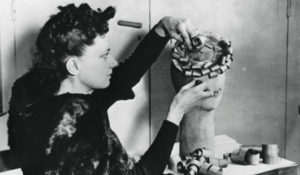The 25th August 2016 marks the 72nd anniversary of the Liberation of Paris from Nazi occupation by the joint Allied forces of the Free French, Great Britain and her colonies, and the U.S.A. Whilst this anniversary might go unmarked in most places besides Paris or France, it is worthwhile to remember that the people of France suffered great deprivation and cruelty under German occupation. French people starved and shivered whilst the Nazi’s took the majority of French’s natural resources for their own use. However, it is worthwhile noting that the German Occupation of France is controversial in the story of WWII as many French people, both out of fear and out of admiration of German politics, collaborated freely with the German occupying forces.
However, there was a large majority of French people, most notably the French Resistance, who resisted both peacefully and physically against the occupation of their country. Fashion in particular in this period was patriotic in subtle ways. A red, white and blue dress on Bastille Day on the 14th of July or extravagant dresses that flaunted the clothes rationing rules. I became interested in how women, and girls, used fashion as a form of political resistance after listening to Stuff You Missed in History Class’s recent podcast on the topic of French sartorial resistance during WWII, entitled Fashion as Political Resistance.
This episode talked about how young women and girls who were sartorially savvy used clothing, fabric and accessories to tactfully show their passive resistance to German occupation. The episode was co-hosted by fashion historian April Callahan, who talked about women using wood shavings to make hats and using cork for soles of their shoes. Of particular interest to readers is the notion of ‘le Systeme D’, which is not a fourth option under the clothes rationing system, but terms from vulgar slang words in French that refer to getting out of tricky situations. Hence, why people used ‘le Systeme D’ for the black market in France or for women or companies who made clothes from unusual materials.

A visitor to a French racecourse wears a high crowned turban style hat. (Photo: David Parker/Fox Photos/Getty Images)
April also talks about the growing extravagance of hats in conveying political messages during the occupation of France. Particularly, the use of turbans with elaborate cardboard scenes of French landmarks, French historical scenes and famous French politicians, singers and actors. In the pictures, you can see one of these extravagant hats that a woman has worn to a race course. This hart or turban would have had internal structures made of wood, bamboo or even matches if wood was scarce!
The 1940s was a time when French youth culture was gaining in popularity as many young French men and women were members of the French resistance. Principally, young girls were wearing red, white and blue blouses, belts or dresses either to invoke anger from the German soldiers or as a blatant show of their French patriotism. This political resistance through the guise of fashion was particularly strong around Bastille Day on the 14th July when young girls could be (and were) arrested for their attire. In the podcast, April Callahan mentions that one girl wore a studded belt with ‘Victory’ or ‘Victoire’ messages in studs which led to her arrest. Consequently, the girl was released when she played ‘dumb’ and the German occupation forces realized that the arrest of a teenage girl would do nothing for morale!
Throughout the podcast, April Callahan and the show’s hosts mention how that after the end of WWII the rest of the western world were horrified at the extravagance of French fashion. Bear in mind that between 1940 and 1944, no foreign journalist attended French fashion shows or displays. In the podcast, it is argued that the women who wore the over the top fashions were stylistically resisting German rule. On the other hand, many designers, models and manufacturers openly collaborated with the German occupiers. It is also mentioned that the young girls who wore political resistance in the form of clothing detested their older counterparts for their blatant embracement of the German administration.
What is clear is that young girls did wear clothing as political resistance to show their allegiance to their country. This method of wearing your heart on your sleeve, quite literally, can be influential to girls who are interested in political causes or are experiencing political oppression in their own countries. It is worthwhile noting that young girls and women who did politically resist the German occupation often met brutal and horrific deaths, just because they chose to wear a patriotic French hat. However, I would definitely recommend the podcast for anyone who is interested in French, WWII or Fashion History.
-Rachel Sayers
Junior Girl
Girl Museum Inc.


